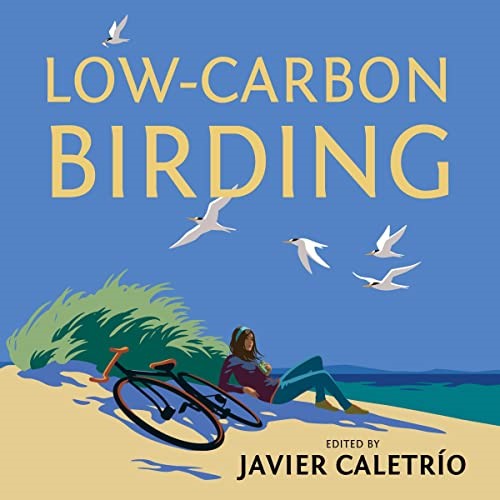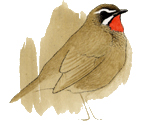 Low-Carbon Birding, 2022 (Javier Caletrío, editor)
Low-Carbon Birding, 2022 (Javier Caletrío, editor)
Javier Caletrío (editor). ISBN 9781784273446. Hardback, 251 pages with 10 b/w illustrations. Pelagic Price: €17,96 at Veldshop. The book has been selected Best Bird Book of the Year 2022 by British Birds and the British Trust for Ornithology.
Birders in most European countries will recognize the uneasy feeling that their birding activities are at odds with the huge effects climate change already has on the natural world. Having started birding myself in the eighties and nineties the world grew smaller with free use of public transport as a student, my first car and increasingly easy and cheap air travel. So yes, I’ve also had my twitching adventures in the Netherlands and I’ve travelled as far as Australia and Venezuela and saw splendid avian wonders in amazing landscapes. But as time grew on me, family life held me back a little and as scientists sounded the alarm on the effects of climate change on entire populations of bird species I altered my own birding style more and more.
Similarly, many birders from different countries, different age groups and walks of life had walked the same path. On Social Media initiatives like Foot It and #LocalBigYear on Twitter sparked my enthusiasm about local and low-carbon birding and that of many fellow birders in the Netherlands, United Kingdom and several other European countries. I had already heard of Javier’s website and now he has done the birding community a big favour: he brought 29 stories together in a very readable book for all of us to enjoy.
It's Boxing Day 2022 and I’ve just finished the last chapter of the book by Alex Lees on the astounding effects climate change is having on whole bird families in the Amazonian rain forest. The chapter before that, written by Kieran Lawrence, underlines the huge effect climate change has on migratory birds. Since so many areas important to these birds’ survival change so quickly, they are unable to keep up with all these changes and fail to adapt and therefore their populations dwindle. If this isn’t reason enough to really have a long thought about your own carbon footprint, Javier lays out all the insights on why long-distance travel for our beloved hobby should be cut back as much as possible. All possible excuses are reviewed and countered, backed up nicely by sound references and research.
But it’s not all worry about the future of our most iconic bird species, nor is it solely filled with insights into the way birding comes with huge downsides if not done thoughtfully. Instead, Low-Carbon Birding is a joy to read, also thanks to all contributors; some of them converted twitchers, some of them hardcore local patchers, others researchers and yet others who take us with them on their low-carbon birding trips abroad. I particularly liked the stories on how local birding can be incredibly rewarding. Birders who have travelled the globe before and twitched the British Isles extensively who end up enjoying their hobby more than ever before now that they have reacquainted with their local area, like Gavin Haig’s account of finding his own local Golden Oriole.
For me Low-Carbon Birding is travelling back in time to when I started birding as a ten-year-old boy. Crashing through the local woods and fields with two friends was like a treasure hunt. We didn’t know much but were surprised by so many wonderful encounters with great birds. Not necessarily rare ones, but still great birds. The way I enjoy my current local birding on the island of Texel is in a lot of ways travelling back to that feeling. I know my areas well and still I am surprised very often by a peculiar species, greater than average numbers of common species, strange behaviour, cool vocalizations etc.
For all of you still travelling abroad for birding trips, twitching across your country or the Western Palearctic in search of new species for your list, take a few hours to read this amazing book and make 2023 the year of reinventing your way of birding. Maybe not cold-turkey, but taking small but definite steps to a more reasonable way of enjoying this great hobby we all share.
The list of chapters with all titles and authors:
ContributorsForeword / Mike ClarkePrefaceAcknowledgements1 Are We Addicted to High-Carbon Ornithology? / Javier Caletrío2 Questions of Travel, Climate and Responsibility / Javier Caletrío3 The Seven Cs of Patch Birding / Nick Moran4 Understanding Our Local Birds / Angela Turner5 Long-term Local Science / Ben Sheldon6 The Perpetual Patch / Roger Emmens7 The Long Rhythms of a Place / José Ignacio Dies Jambrino8 A Life of Local Birding / Matt Phelps9 The Joys of Patch Birding / Maria Scullion10 A Patch Year / David Raffle11 Hunting Hawfinch / Steve Gale12 In Praise of ‘Projects’ / Mark Bannister13 The Backyard Jungle / Finley Hutchinson14 My Patch and the Plastic Problem / Siân Mercer15 Eleventh-Hour Birding / Simon Gillings16 Listening Again to Birdsong / Dave Langlois17 The Sound of Summer / Arjun Dutta18 Birding in the Yorkshire Dales / Steve Ward19 TG42 / Tim Allwood20 Shrikes from the Bike / Dave Langlois21 The Best Kind of Golden Oriole / Gavin Haig22 From Angst to Tranquillity / Jonathan Dean23 Redrawing My Birding Horizons / Sorrel Lyall24 Island Holidays by Train / Amy Robjohns25 Lammergeyers from Leeds / Jonnie Fisk26 Bringing Birding Home / Nick Acheson27 Little Steps, Big Difference / Steve Dudley28 Climate and the Cuckoo Calendar / Lowell Mills-Frater29 Climate Change in the Kalahari / Amanda Bourne30 Unsettling Journeys / Kieran Lawrence31 Witness to Extinction / Alexander LeesAfterwordNotesIndexVincent Stork




